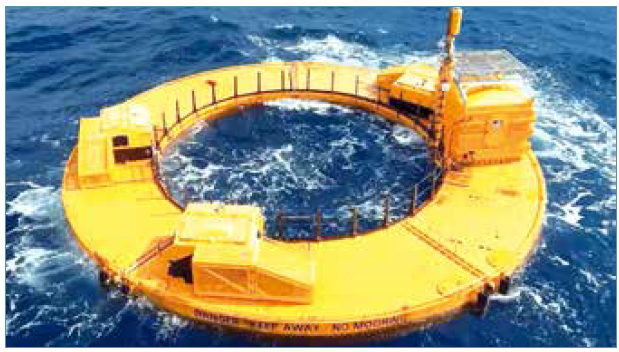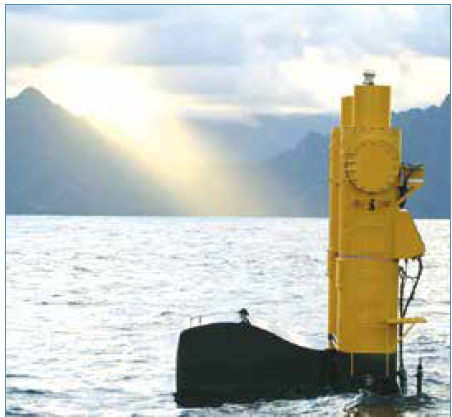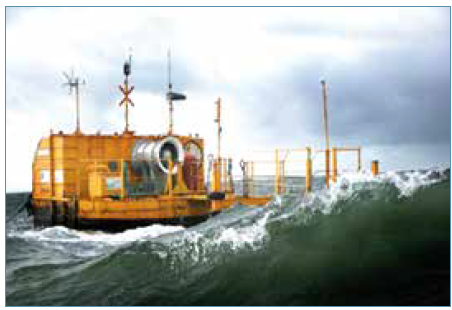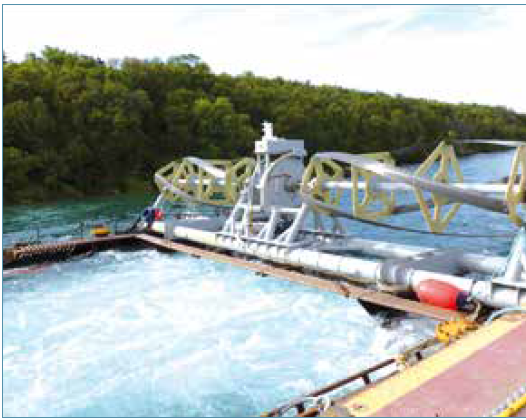UNITED STATES OF AMERICA
TECHNOLOGY DEMONSTRATION
OPEN SEA TEST SITES
The development of comprehensive testing infrastructure is a strategic imperative for the Program to successfully address sector challenges, as outlined in the draft strategy. Test facilities offer diverse testing services addressing technical and nontechnical barriers of MHK commercialization. Prototype testing is essential to advance existing MHK technologies, validate performance against analytic models, and demonstrate compliance with applicable design standards.
Testing mitigates the technical and financial risk of developing and deploying MHK energy devices, plants, technologies, and related products. By supporting the development of testing infrastructure, the Program ensures that many more prototypes from a diverse set of technology developers can be tested than if each technology developer had to carry the cost burden of developing, permitting, and installing its own test facility. As a result, promising technologies that could have failed due to insufficient funds have a chance to succeed.
Navy’s Wave Energy Test Site (WETS): The U.S. Naval Facilities Engineering Command operates an ocean wave energy test site facility located at Marine Corps Base Hawaii in Oahu’s Kaneohe Bay. The facility includes infrastructure to support offshore testing of a point absorber or oscillating water column device with up to a three-point mooring configuration.
In 2015, construction was completed of two additional grid-connected test berths at 60-meter and 80-meter depths for 100 kW to 1 MW wave energy converters (WECs). The Navy also operates a grid-connected test berth at a depth of 30 meters. Pacific Marine Energy Center (PMEC) – Wave and Current Test Facilities: Pacific Marine Energy Center (PMEC) is the marine energy converter testing facilities arm of the Northwest National Marine Renewable Energy Center (NNMREC).
Just as the European Marine Energy Center has a variety of sites based on scale and technology, PMEC offers a range of test facility types. For wave energy testing, PMEC supports two operational test sites: the North Energy Test Site (NETS) off the coast of Newport, Oregon, and Lake Washington in Seattle, Washington. NETS has a mobile Ocean Sentinel test buoy that facilitates open-ocean, stand-alone testing of WEC devices with average power outputs up to 100 kW. Current turbines up to 10 kW power output can be tested at the Tanana River Test Site (TRTS) in Alaska.
Pacific Marine Energy Center - South Energy Test Site (PMEC-SETS) and the California Wave Energy Test Center (Cal-Wave) – Wave Test Facilities (Under Development): In 2016, NNMREC and California Polytechnic State University continued developing preliminary designs and cost estimates for full scale, open-ocean, grid-connected wave energy test facilities, PMEC-SETS and CalWave respectively. PMEC-SETS is located off the coast of Newport, Oregon. CalWave has investigated and characterized several potential locations for a wave energy site offshore of Vandenberg Air Force Base in Southern California. Researchers continued preliminary design and cost estimates for a selected location and began the permitting process in 2016. At the end of 2016 the Program selected PMEC-SETS as the recipient of up to $40 million in federal funding, subject to appropriations, to design, permit, and construct the PMEC-SETS national wave energy testing facility. Following construction, PMEC-SETS will serve as a wave energy test facility for evaluating full-scale WEC device performance, environmental interactions, and survivability.
Southeast National Marine Renewable Energy Center (SNMREC) – Ocean Current Test Facility: SNMREC, operated by Florida Atlantic University, is working to advance research in open-ocean current systems by building the capability, infrastructure, and strategic partnerships necessary to support technology developers on the path to commercialization. In addition to a remarkable collection of Florida Current resource and biological data for MHK site selection and equipment design, the center offers onshore and offshore testing capabilities. Onshore, a 25-kW dynamometer provides drive train and generator performance evaluation with ocean current data emulated from field measurements. Offshore, developers can use towed testing or component testing with a 3 m, 25-kW horizontal axis research turbine and in-water rotor testing platform. Grid-connected, full-scale test berths are under development.
Hawaii National Marine Renewable Energy Center (HINMREC) – Wave Test Facility and Ocean Thermal Energy Conversion (OTEC): HINMREC’s mission is to facilitate the development and commercialization of WEC devices and to assist the private sector with moving ocean thermal energy conversion systems beyond proof-of-concept to pre-commercialization. HINMREC supports the Navy in the operation of WETS, providing independent assessment of the power performance (i.e., power output as a function of wave environment) of pre-commercial WEC devices tested therein, while also evaluating their potential environmental impact by measuring acoustic emissions and performing ecological surveys in the ocean area surrounding moorings and along the submarine power cables connected to the electrical distribution system.
The Jennette’s Pier Wave Energy Test Facility: Jennette’s Pier is owned by the state of North Carolina and managed by the NC Aquarium Division. The University of North Carolina Coastal Studies Institute (UNC CSI) began a partnership with Jennette’s Pier in 2004 to foster research, ocean energy device testing and monitoring, outreach, and education. Part of this partnership is the Jennette’s Pier Wave Energy Test Center. The site has two test berth locations, one at 6 m water depth and one at 11 m depth. The wave climate at the test site varies seasonally, with calmer seas in the summer compared to more energetic seas in the winter.
U.S. Army Corps of Engineers (USACE) Field Research Facility (FRF): The Field Research Facility is near the town of Duck, North Carolina. Central to the FRF is a 560-m-long, steel-and-concrete research pier that extends to the ~7 m water depth contour. FRF researches weather, waves, currents, tides, and beach change. The 10-person staff of computer specialists, technicians, and oceanographers are known for their ability to collect data, design experiments, and conduct research. The USACE FRF offers a wide range of technical and testing infrastructure support services for WEC developers. The site has small scale, shallow water wave energy resources, and can accommodate scaled devices. The research pier can serve as a cable conduit through the surf zone to locations on land.
Center for Ocean Renewable Energy (CORE): CORE, located in and around Durham, New Hampshire, was founded in 2008 and provides multiple-scale research, technology development and evaluation, education, and outreach for issues related to ocean renewable energy systems. CORE’s physical infrastructure consists of the Chase Ocean Engineering (OE) Laboratory with wave/tow tank, engineering tank and water/wind tunnels, the General Sullivan Bridge tidal energy site, the UNH Pier and the AMAC/wave energy site. Mooring grids, historical environmental and survey data, and support vessels are available.
The University of Maine: The University of Maine has the ability to test at three different scales to support the development of new offshore renewable energy devices. Developed with over $20M of federal and State funding to support UMaine’s own technology development effort for floating wind turbines, three test sites have been developed to qualify ew technologies through 1/50 to 1/20 testing in a 100ft x 30ft x 15ft wave tank, intermediate scale testing (1/10 to 1/4) in a sheltered grid-connected offshore site off the Maine coast, and full-scale testing at an offshore test site located approximately 11 miles off the coast of Maine.
OPERATIONAL PROJECTS
|
Fred. Olsen: Fred. Olsen Autonomous Sea Power’s wave energy converter, the BOLT Lifesaver, was installed at WETS on March 26, 2016. BOLT Lifesaver operates autonomously and operation has mainly been monitored and controlled from Fred. Olsen’s headquarters in Oslo, Norway. Out of the 280 days installed in 2016, the device has been in power production 218 days, or 78% of the time, producing a total of 17.955 kWh at an average of 3.4 kW. Notably, the device has been in uninterrupted power production since July 19 (165 days). The current deployment expires in March 2017. Fred. Olsen is looking to further extend the deployment. |
 |
PLANNED DEPLOYMENTS
|
Northwest Energy Innovations (NWEI): NWEI’s Azura™ is a multimode, “point absorber” wave energy device that extracts power from both the heave and surge motions of waves to maximize energy capture. NWEI has previously tested their technology in Oregon in 2012, and a half-scale device was tested with 98% availability for 19 months beginning in June 2015 at the 30 m berth at WETS. With funding from the Program, NWEI will design, fabricate, and test a full scale Azura™ wave energy device to reduce the LCOE and demonstrate commercial viability at a deep water berth at U.S. Navy’s WETS in Hawaii. The proposed testing will allow NWEI and its team to determine the energy capture matrix of a full scale device, resulting in a more accurate assessment of LCOE. |
 |
|
|
This project will leverage lessons learned from three years of extensive scale model testing in Galway Bay, Ireland, that identified design opportunities to lower the cost of electricity and make these design improvements to the OE Buoy technology for a full scale deployment at WETS. The open water demonstration of the buoy will gather baseline performance data, gain operational experience, and identify further cost reduction opportunities for oscillating water column devices. Comprehensive LCOE validation data will also be generated during the 12-month deployment commencing in 2017. |
 |
Columbia Power Technologies: Columbia Power Technologies will conduct an open-ocean demonstration of a largescale StingRAY at WETS in 2018 in a project co-sponsored by the DOE and Navy. The StingRAY is a hybrid design that benefits from the characteristics of both point absorbers and attenuators, significantly increasing energy capture, availability, and survivability. The StingRAY has a composite hull and two large-diameter, direct-drive permanent-magnet-generators and is intended for offshore, utility-scale wave farms. In early 2016, Columbia Power received a Statement of Feasibility from DNV GL for version 3.2 of the StingRAY design. The WETS StingRAY—resulting from 10 years of product development effort, five scaled-prototype tank-tests and three sea trials—will be deployed at the 80-m WETS berth and will demonstrate improvements offering lower-cost installation, operations and maintenance.
Verdant Power: Verdant’s Kinetic Hydropower System (KHPS) is an axial flow current-capturing turbine system. Proposed is a highly integrated approach to the simultaneous design of a suitable mounting system and accompanying operational process for cost-effective installation, maintenance, and retrieval. Verdant and its partners will build on prior work to complete the nominal solution of a TriFrame (TF) that optimizes turbine spacing and structural requirements to allow for cost-effective Installation, Operation, and Maintenance (IO&M), including retrieval of three turbines with one on-water operation. Completing, and proving through testing, the final TF design and accompanying IO&M procedures, will be a major step in providing a commercial KHPS system. The design process, along with the specific results of economic tradeoff studies of single turbine versus tri-frame deployment concept and the investigation of applicability of these results to soft substrates, will be useful to other MHK developers.
|
Igiugig Village Council and Ocean Renewable Power Company: The project will implement, test (full-scale) and validate the system improvements which have been identified, designed, and analyzed. The project will reduce energy costs and offset diesel generation in remote locations. A reliable and durable RivGen Power System will provide a model for HK project implementation using local equipment and resources that is replicable in Alaska and nationally. |
 |
Resolute Marine Energy: The Program has supported Resolute Marine Energy in the development of intelligent feedback and feed-forward control algorithms for use in its next-generation Oscillating Wave Surge Converter (OWSC). The control systems will first be tested on a reduced-scale version of RME’s wave-powered desalination/electricity generation system in RME’s land-based development center. Upon completion of these tests, RME will then deploy a full-scale system at Camp Rilea, Oregon, for approximately one year of ocean trials. During the Camp Rilea tests, RME will also be evaluating a novel deployment and retrieval system which utilizes logistic-over-the-shore technologies (LOTS) developed by the U.S. military services. The goals of this aspect of the Camp Rilea test program include improving safety, reducing downtime associated with repair and maintenance operations, and measuring the effects on costs.



